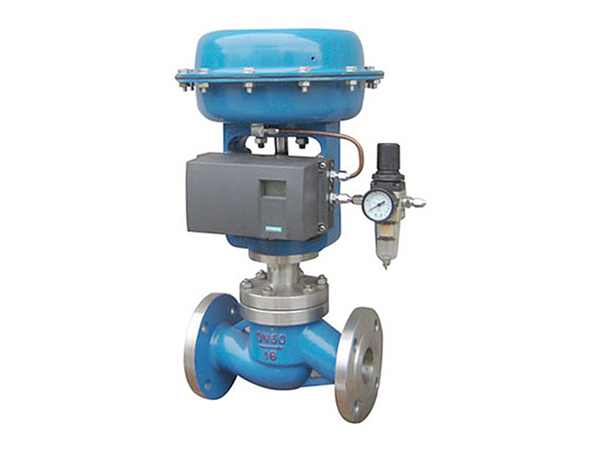NEWS
- News Type
- Industry dynamics
- Company News
- Technical knowledge
The handling methods for faults in control valves

Pneumatic control valves use compressed air as the power source, a cylinder as the actuator, and drive the valve with the help of valve positioners, converters and other accessories to achieve on-off or proportional regulation. They accept control signals from industrial automation control systems to complete the regulation of various process parameters such as flow, pressure and temperature of pipeline media.
At present, pneumatic control valves are widely used in process industries such as petrochemical, power and metallurgy, and are an indispensable and important link in control systems. Therefore, it is very important to ensure the stable and reliable operation of pneumatic control valves. When a pneumatic control valve malfunctions, it can be checked based on common faults of the control valve to promptly identify the cause of the fault.
1. Gas source failure
▶ The on-site gas source has not been turned on.
▶ The gas source contains water and freezes in cold weather.
▶ The supply of purified air has been stopped.
▶ Leakage of the main air source pipe or blockage of the air line causes the air pressure to be too low, and the regulating valve cannot be fully opened or fully closed, or even does not act at all.
▶ The air filter pressure reducer has been used for a long time, and there is too much dirt. The black knob under the pressure reducing valve opens to leak air, causing the output air pressure to be lower than the specified pressure. As a result, the regulating valve cannot be fully opened or closed, or even does not act at all.
▶ The on-site air line is leaking air and the joints are loose, resulting in insufficient air pressure. The regulating valve cannot be fully opened or closed, or even does not act at all.
▶ The filter pressure reducing valve malfunctioned, causing unstable air pressure and resulting in the oscillation of the regulating valve.
2. Line Faults
▶ The power cord connection terminals are loose, fallen off, short-circuited or open-circuited. Excessive dust accumulation on the circuit board leads to poor contact, signal fluctuations and vibration of the regulating valve.
▶ After heavy rain or typhoons, water enters the equipment and gets damp, causing short circuits in the wiring and resulting in the control valve being unable to fully open or fully close.
▶ Reversing the polarity will cause the regulating valve not to operate.
▶ The middle section of the power cord malfunctioned. Due to the failure of the insulating tape, the insulating sheath of the wire fell off, causing a short circuit between the wires. The on-site vibration led to the wire breaking, resulting in the discontinuous oscillation of the regulating valve, which could not be fully opened or fully closed, or even did not operate at all.
▶ Due to wiring errors after the maintenance of the control valve, the control valve malfunctioned.
▶ The output signal of the control valve is unstable, causing fluctuations in the operation of the control valve.
3. Locator failure
▶ The fixing nut of the feedback rod became loose and fell off, and the spring on the feedback rod also fell off, causing the feedback rod to become loose, fall off and get stuck, which led to the oscillation of the control valve.
▶ The position sensor in the positioner malfunctions. When it vibrates to a bad point, it will cause the display in the central control room to exceed the range. After a while, it will return to normal. The problem can be solved by replacement.
▶ The PID parameter tuning of the locator is inappropriate;
4. Failure of the regulating valve body
▶ Wear of the valve core or valve seat of the control valve (scratches and wear caused by the erosion of the medium, rust, welding slag and other dirt), jamming (blockage caused by various impurities in the medium), poor sealing (wear of the sealing ring), resulting in the medium still being in excess when the valve is fully closed and unable to be controlled.
▶ If the packing of the control valve is pressed too tightly or too loosely, if it is too tight, the valve stem of the control valve will move slowly or jump; if it is too loose, the medium will leak. If it is heavy oil, it is very likely to catch fire, causing a major accident.
▶ When installing the control valve, if the pipeline and the valve body are not concentric, the control valve will be subjected to excessive additional stress, causing oscillation, inability to fully open or fully close, etc.
▶ The fixing nut between the valve stem and the connecting part of the regulating valve is loose, and the valve stem and the valve core are not concentric, which causes the valve not to close properly. The stress it is subjected to increases, resulting in high-frequency oscillation of the valve stem and even breakage.
▶ The diaphragm head of the control valve malfunctions. Due to long-term use of the diaphragm, it ages and deteriorates, its elasticity decreases, and its sealing performance deteriorates. The diaphragm leaks air, and the compression spring ages, its elasticity decreases, and it breaks, causing the control valve to fail to fully open or close, or even lose control. The valve core of the control valve may fall off, the valve core and the valve seat may get stuck, and the valve stem may bend or break, which will cause the control valve to operate normally but fail to play a regulating role.








